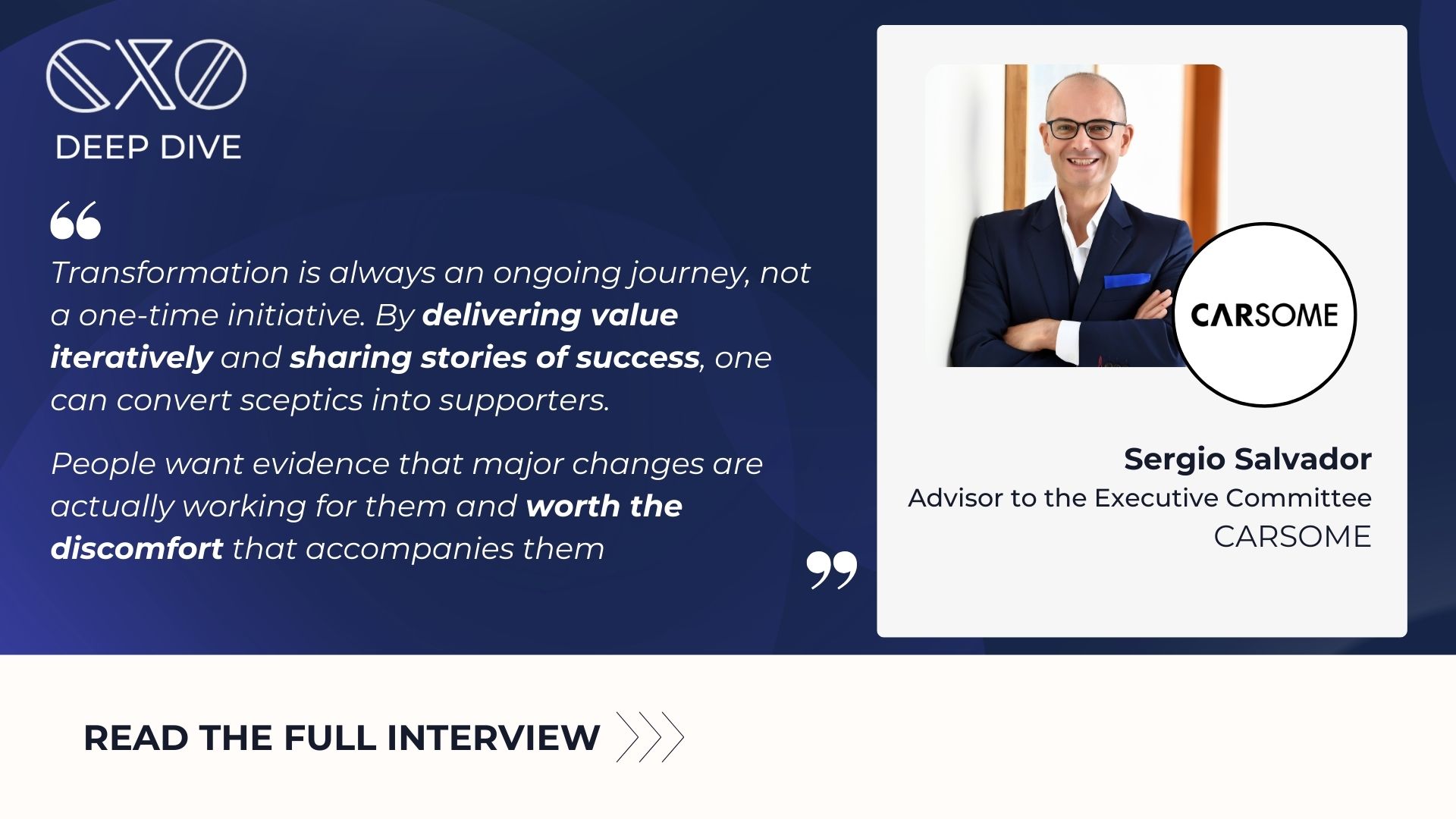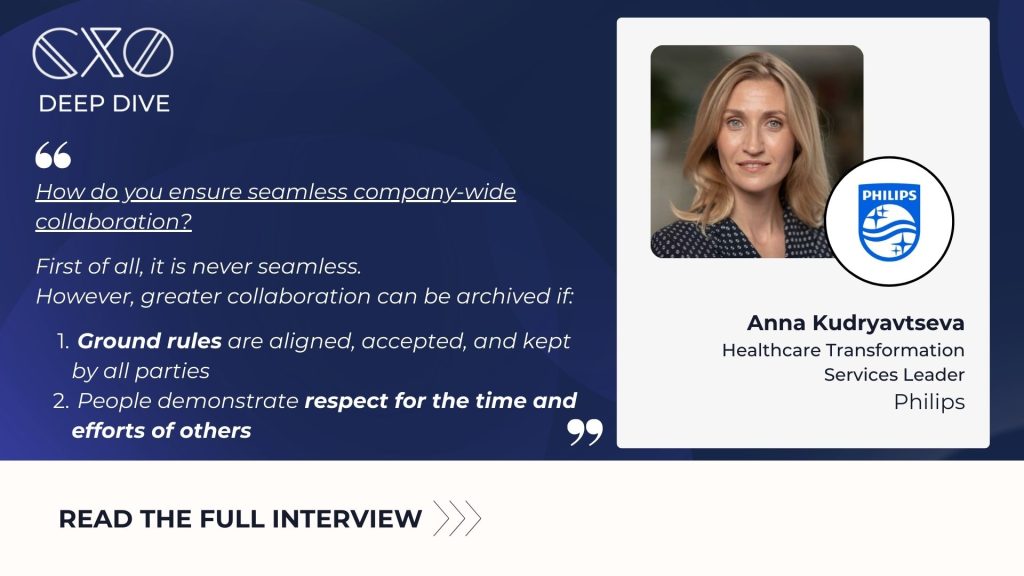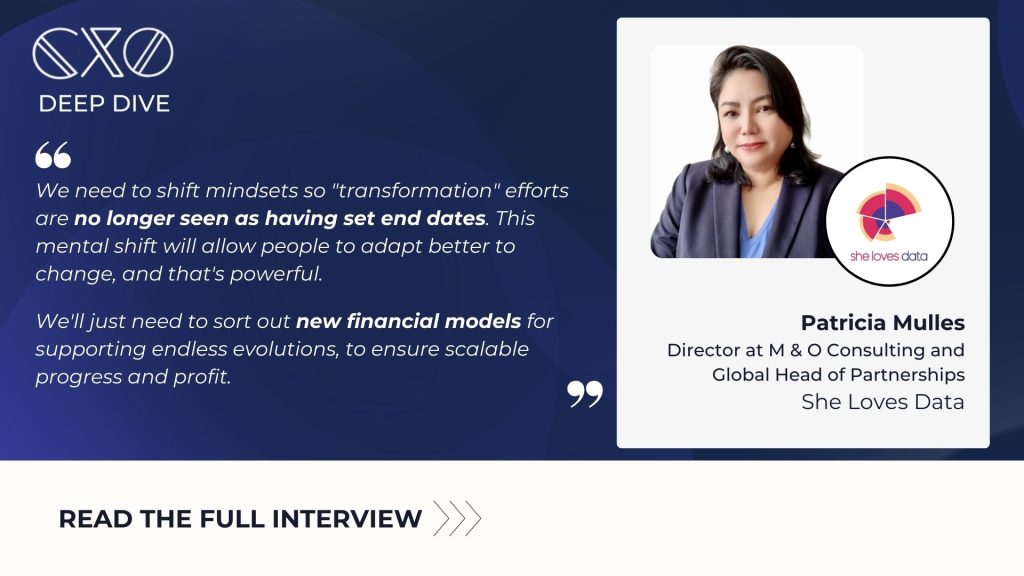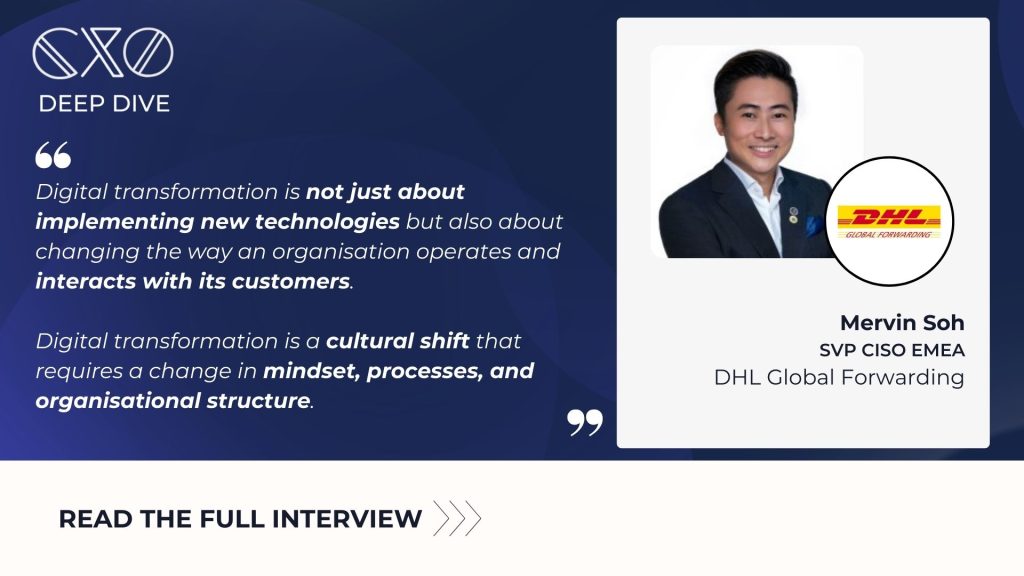Sergio Salvador, Advisor to the Executive Committee, CARSOME shares his insights and experiences on Transformation Strategy & Organisational Transformation as part of the CXO Deep Dive series.
How would you explain your job to a 5-year-old?
A company is kind of like a big machine with lots of parts that all need to work together. Sometimes, the company machine gets old and rusty and doesn’t work as well anymore. When that happens, they need someone to come help fix it up, starting with the people in the company. I help fix up company machine parts so they can work together faster and better.
I look at all the different parts of the company, like the employees, but sometimes also the technology, the products and services, the processes, etc. Then I look for ways we can make them run more smoothly again as a whole machine. And then, I get to make updates and repairs.
It can be tricky because we can’t stop the machine while we fix it – companies still need to keep running. So I have to figure out how to change parts or oil squeaky wheels while every employee keeps doing their jobs. But it’s an important job to help companies work as well as possible.
“There is no digital transformation, just transformation.” Do you agree or not? Why?
The term “digital transformation” has become overused and misinterpreted. Too often, it is taken to mean simply digitising existing processes and documents by moving them online in the cloud or into software. But true transformation requires rethinking and reimagining processes, customer experiences, business models and, most importantly in my opinion, organisational culture and all aspects of the employee experience.
Moreover, digitisation is not the same as transformation. You can digitise processes without actually changing them substantively. Likewise you can adopt the latest technologies without reshaping the core aspects of your business. Technology today has become so commoditised that most technology solutions can be done with off-the-shelf components, anyway. True transformation goes much deeper than technology to create more meaningful and sustainable change.
Transformation is about continuous improvement, adaptability and new ways of thinking and operating. It’s easy to get distracted by shiny digital tools and capabilities and lose sight of the underlying changes in experiences and culture necessary. We should not conflate adopting new technologies with the hard work of repositioning and realigning the organisation for the future, and instead create a growth mindset culture that constantly evolves. After all, the average lifespan of a company in the Standard and Poor’s 500 Index was 21 years in 2020. This is down from 32 years in 1965. Very similarly, the average lifespan of a listed company in the U.S. stock market is also about 20 years. A main reason for this lifespan reduction is failing to evolve fast enough.
I am encouraged to see the “digital” modifier being increasingly dropped from the expression “digital transformation,” as we must recognise that business transformation must place people first, and technology second. Achieving meaningful evolution requires changing behaviours, skillsets, procedures and strategies. The essence is in the organisational and cultural shifts, enabled not just (or even primarily,) by digital capabilities. It’s ultimately about fundamental reinvention, which is what transformation is all about.
“It’s crucial to deliver and communicate benefits fast, to build momentum and confidence in transformation projects where there might be scepticism.”
Do you agree? Or you have other thoughts on the timeline of a transformation project?
This is an excellent point. Major transformation initiatives can only succeed when everyone, from stakeholders, to leaders, to boards, and every single employee supports the effort, which can take years. According to a report by McKinsey from several years ago, seventy percent of transformations fail, and the main reason for this is the loss of momentum bringing people along.
Any initiative that helps bring people along can contribute to increasing the chances of succeeding, therefore, it is vital to deliver and communicate benefits rapidly in order to gain buy-in among stakeholders. Ultimately, no matter the level of loyalty or enthusiasm by each stakeholder, change agents must answer the question of “what’s in it for me?”
Transformation efforts, almost by definition, challenge the status quo and force people out of their comfort zones. That can inevitably breed resistance and scepticism among both leadership and staff. People are more inclined to support changes when they see those changes actively improving their jobs, the performance of the organisation, and when they see direct benefits to them.
By focusing on quick wins – whether it’s faster processes, better customer experiences, new incentives, higher productivity or other tangible gains – a change agent can showcase “proof points” that the transformation is yielding real, practical payoffs.
Transformation is always an ongoing journey, not a one-time initiative. By delivering value iteratively and sharing stories of success, one can convert sceptics into supporters. People want evidence that major changes are actually working for them and worth the discomfort that accompanies them. Early (and ongoing!) wins are crucial to building that confidence and maintaining the backing we need to sustain transformational change.
Do you see transformation as a distinct skillset, best delivered by “Transformation Experts”, or is it better to be led by the core business?
In order to have a greater chance of succeeding, true organisational transformation must be driven from the top down, with committed sponsorship and participation from all leadership. However, establishing a strategy, urgency, a vision and capability for that change does require a central guiding change agent, an orchestrator who ensures the violins are aligned with the cellos and flutes.
Having an executive-level transformation leader is indispensable for spearheading major evolution initiatives. They establish priorities, secure resources, maintain cross-functional alignment and accountability, and model the desired mindsets and behaviours inherent in the change.
Transformation cannot be delegated or outsourced to a specialised team. The responsibilities and expectations for supporting and embracing change must permeate through every layer of leadership. Managers especially play a crucial role, both in reshaping their own operations and processes as well as in serving as influencers to encourage adoption among their direct reports. A sceptical manager can derail the best transformation strategy.
If the mandate, vision and progress for transformation live only within specialised change agents, the risk is that business units revert to old behaviours the moment a formal initiative is declared finished. The programmatic elements of transformation initiatives come and go, but genuine organisational change is continual. As such, that ethos of agility, innovation and ongoing improvement must become ingrained into the fabric of leadership.
Transformation ultimately relies on networks of inspired, equipped leaders collectively shepherding change within their spheres of influence, and playing to the same tune. So while centralised change agents can drive critical focus, it is distributed leadership – role modelling, communicating, aligning structures and processes – that translates vision into sustainable new ways of operating.
What aspect(s) of business should organisations prioritise during digital transformation? Why?
There are several critical areas, but the first one to look at no matter what, is people. None of the investments (including technology investments) will matter without first effecting changes in mindsets, processes and skillsets within the organisation itself. Nurturing growth mindset cultures, upskilling employees and evolving the culture are essential to unlocking the full benefits.
Transformation should also aim to provide greater business agility, to rapidly adapt to market changes, launch innovations faster, and pivot operations before external disruptions happen, if at all possible.
Another one of the most important areas to focus on is improving customer experiences by leveraging digital technologies. This includes things like offering omni-channel interactions, personalised recommendations, and simplified processes. Transforming customer experiences is critical for meeting rapidly changing expectations.
Finally, making better data-driven decisions is crucial. Organisations should focus on building analytics capabilities, performance dashboards and enterprise-wide data availability so that insights can inform everything from strategic planning to day-to-day operations. This includes data around people, and I don’t simply mean areas like productivity. I mean true talent intelligence initiatives that have direct consequences in terms of improving the overall employee experience by empowering people and giving them more agency on how to do their jobs.
The overarching focus should be creating more resilient, innovative and responsive operating models, driven by an empowered and upskilled workforce capable of continually adapting at scale. Prioritising these foundational areas helps set up organisations for increasing agility, efficiency and competitive differentiation over time.
What do you ultimately do with people that do not want to change?
Dealing with people resistant to change is one of the most challenging aspects of leading transformation.
While there are no easy answers, in my experience there are a number of things that can potentially work, all coming from a basis of empathy and support.
Listen empathetically to understand sources of resistance as objections may come from valid concerns about loss of status, power, pay or comfort. Things that may be deeply personal. Identifying real root causes may allow for the creation of targeted solutions to bring those employees along.
Communicating frequently can also help, as a lack of information can easily breed resistance. Continual engagement to explain the rationale, vision and benefits can help counteract scepticism.
Most critically, involve resisters early as they can derail initiatives to bring people along. Giving voice to objections, always from a base of respect, can help fine-tune the strategy and build inclusiveness for those at risk of feeling marginalised.
It’s important to make changes as easy to adopt as possible. Simplify training, provide job aids, and align measures and processes to smooth the transition pathway.
And finally, tailor consequences. Set clear expectations on behavioural changes required, and for those unwilling to make those changes, discuss suitability for the role, provide support, and let go of those who remain barriers.
What technology / solution would you invest in if you were an Angel Investor?
I happen to be an angel investor! I personally spread my bets as long as the company is developing tech-focused or tech-enabled solutions to existing problems. GenAI is of course a hot market at the moment, but I think there is also a bit too much hype, which makes it difficult to identify the best solutions to real problems.
What’s the best advice someone has ever given you regarding transformation?
Think Big, Start Small, and Act Fast. This is almost an evolved version of a saying we used to have at Google during my time there.
A big thank you to Sergio for sharing the insights on Transformation Strategy & Organisational Transformation!
Visit our content library for more insights from the CXOs: https://cxoinnovation.com/content-library/
Join our LinkedIn CXO Community.





